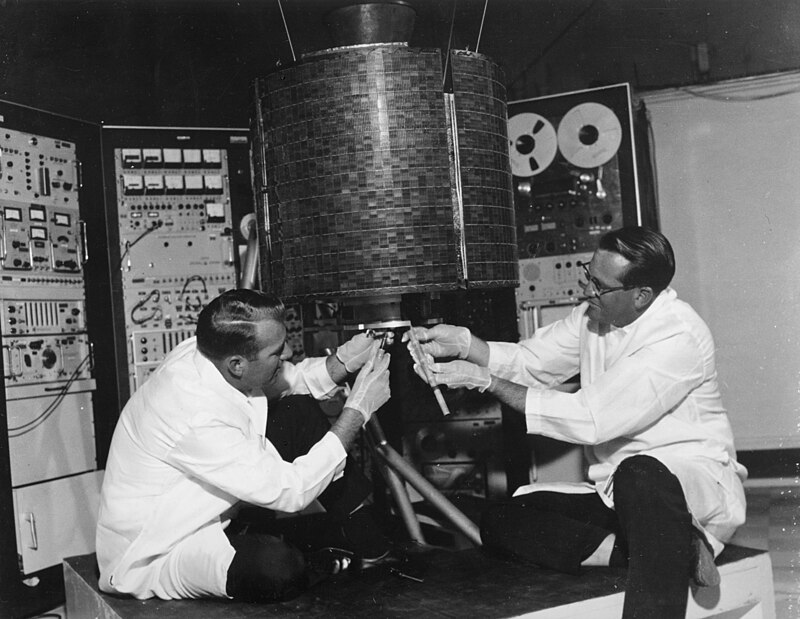
Engineers Stanley R. Peterson (left) and Ray Bowerman check-out Intelsat I or Early Bird prior to launch from Complex 17a, Cape Kennedy (now Cape Canaveral), Florida on 1965 April 6. (Image Sources: NASA, Wikipedia.org, By NASA - Great Images in NASA Description, Public Domain, https://commons.wikimedia.org/w/index.php?curid=686174)
By Glenn A Walsh
Reporting for SpaceWatchtower
April marks the 60th anniversary of the orbiting of Intelsat I, the first commercial, geostationary satellite. Also known as Early Bird, the geostationary satellite was popularized 20 years earlier by the famous science-fiction writer and scientist Arthur C. Clarke.
Intelsat I entered a geostationary orbit on 1965 April 6, as the first commercial communications satellite to achieve such an orbit. After some maneuvering, the satellite settled in an orbit over the Atlantic Ocean at 28 degrees West Longitude, where it began commercial service.
Constructed by the Space and Communications Group of Hughes Aircraft Company (later known as the Hughes Space and Communications Company and now known as the Boeing Satellite Systems). It was built for COMSAT (Communications Satellite Corporation), which activated the satellite on 1965 June 28.
Early Bird was based on a series of Syncom satellites built for NASA by the Hughes Aircraft Company. These experimental satellites proved the concept of communications by geostationary satellites.
Early Bird helped to provide live television coverage of the splashdown of the NASA Gemini 6 crewed spacecraft, in December of 1965. Early Bird also was one of the satellites used for the 2-hour Our World, the first live multi-national, multi-satellite television broadcast on 1967 June 25.
Early Bird provided commercial communications services for 4 years and 4 months, ending regular service in January of 1969. It was briefly reactivated in June of 1969 (until 1969 August) to assist in the mission of the NASA Apollo 11 (which was the first mission to land 2 astronauts on the Moon), due to the failure of the then-Atlantic Ocean Intelsat satellite.
Early Bird was the first satellite to provide direct and nearly-instantaneous television, telephone, and telefacsimile transmissions between North America and Europe.
Early Bird was also briefly reactivated for the 25th anniversary in 1990. Today, Early Bird remains in orbit, inactive as a communications satellite.
A geostationary orbit is also known as a geosynchronous equatorial orbit (GEO). The height above the Earth or altitude of such an orbit is 22,236 statute miles / 35,786 kilometers.
When placed in such an orbit, a satellite orbits the Earth at the same rate of speed as the rotation rate of the Earth. Consequently, the satellite seems to remain fixed in one location above the Earth, even though it is always moving in orbit around the Earth. To match the Earth's rotation rate, the satellite travels at approximately 7,000 statute miles per hour / 11,300 kilometers per hour.
It was in a 1945 paper titled, “Extra-Terrestrial Relays”, that famous science-fiction writer and scientist Arthur C. Clarke proposed using satellites in geostationary orbit as a way to relay radio messages around the world, without the need of cables under the oceans. The proposal was published in the 1945 October issue of the magazine, Wireless World.
In his 1945 article, he discussed the problems of long-distance radio and telephone communications. He maintained that the ionosphere distorted long-distance radio signals, and television signals could not be transmitted by long-distances, without expensive relays about every 50 miles. Arthur C. Clarke wrote, “A relay chain several thousand miles long would cost millions, and transoceanic services would still be impossible”.
He proposed converting the German V2 rockets to more powerful, radio-controlled rockets which could lift “a second moon” into orbit. In addition to relaying communications transmissions, he also suggested that this could be a “space station” where astronomers and other scientists could study astronomy, physics, and meteorology.
In the article, he proposed the launch of a series of GEO communications satellites, which would be equi-distant from one-another around the globe. For complete coverage of the Earth, these satellites would be linked to one-another and to the Earth by radio or optical beams (there was no fully functioning laser until 15 years later, on 1960 May 16, although Albert Einstein established the theoretical foundations for a laser in a 1917 scientific paper).
Internet Links to Additional Information ---
Intelsat I / Early Bird: Link >>> https://en.wikipedia.org/wiki/Intelsat_I
Arthur C. Clarke: Link >>> https://en.wikipedia.org/wiki/Arthur_C._Clarke
"Clarke Suggests Geosynchronous Orbit": Link >>> https://ethw.org/Clarke_Suggests_Geosynchronous_Orbit
"The 1945 Proposal by Arthur C. Clarke for Geostationary Satellite Communications";
Link >>> https://lakdiva.org.lk/clarke/1945ww/
Source: Glenn A. Walsh Reporting for SpaceWatchtower, a project of Friends of the Zeiss
"60 Years Ago: Arthur C. Clarke's Vision of Geostationary Satellites Comes True"
Sunday, 2025 April 6.
Artificial Intelligence not used in the writing or production of this article.
© Copyright 2025 Glenn A. Walsh, All Rights Reserved
Like This Post? Please Share!
More Astronomy & Science News - SpaceWatchtower 'X' / Twitter News-Feed:
Link >>> https://twitter.com/spacewatchtower
Astronomy & Science Links: Link >>> http://buhlplanetarium.tripod.com/#sciencelinks
Want to receive SpaceWatchtower blog posts in your in-box ?
Send request to < spacewatchtower@planetarium.cc >.
gaw
Glenn A. Walsh, Informal Science Educator & Communicator (For more than 50 years! - Since Monday Morning, 1972 June 12):
Link >>> http://buhlplanetarium2.tripod.com/weblog/spacewatchtower/gaw/
Electronic Mail: < gawalsh@planetarium.cc >
Project Director, Friends of the Zeiss: Link >>> http://buhlplanetarium.tripod.com/fotz/
SpaceWatchtower Editor / Author: Link >>> http://spacewatchtower.blogspot.com/
Formerly Astronomical Observatory Coordinator & Planetarium Lecturer, original Buhl Planetarium & Institute of Popular Science (a.k.a. Buhl Science Center), America's fifth major planetarium and Pittsburgh's science & technology museum from 1939 to 1991.
Formerly Trustee, Andrew Carnegie Free Library and Music Hall, Pittsburgh suburb of Carnegie, Pennsylvania, the fourth of only five libraries where both construction and endowment funded by famous industrialist & philanthropist Andrew Carnegie.
Author of History Web Sites on the Internet --
* Buhl Planetarium, Pittsburgh: Link >>> http://www.planetarium.cc Buhl Observatory: Link >>> http://spacewatchtower.blogspot.com/2016/11/75th-anniversary-americas-5th-public.html
* Adler Planetarium, Chicago: Link >>> http://adlerplanetarium.tripod.com
* Astronomer, Educator, Optician John A. Brashear: Link >>> http://johnbrashear.tripod.com
* Andrew Carnegie & Carnegie Libraries: Link >>> http://www.andrewcarnegie.cc
* Other Walsh-Authored Blog & Web-Sites: Link >>> https://buhlplanetarium.tripod.com/gawweb.html